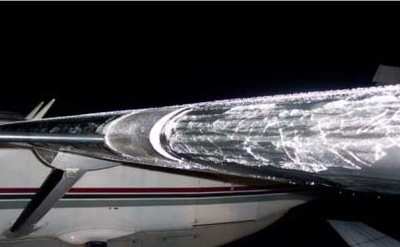Wed, Feb 28, 2007
Recommends FAA Mandate Auto-Cycling Deicing Boots
 On Tuesday, the National
Transportation Safety Board issued a sweeping set of
recommendations, all stemming from the February 16, 2005 loss of a
Cessna Citation near Pueblo, CO. Six Circuit City Stores employees
and two pilots were lost in the accident.
On Tuesday, the National
Transportation Safety Board issued a sweeping set of
recommendations, all stemming from the February 16, 2005 loss of a
Cessna Citation near Pueblo, CO. Six Circuit City Stores employees
and two pilots were lost in the accident.
As Aero-News reported last
month, the Board determined the accident was caused by
the flight crew's failure to effectively monitor and maintain
airspeed, and comply with procedures for deice boot activation on
their approach to Pueblo, CO, which led to an aerodynamic stall.
Contributing to the accident was the FAA's failure to establish
adequate certification requirements for flight into icing
conditions -- which led to the inadequate stall warning margin
provided by the airplane's stall warning system.
In addition to recommendations emphasizing additional training
on the Cessna 560's deicing systems, and the aircraft's flight
characteristics in icing conditions, the Board also recommends the
FAA require proper training on all aircraft equipped with pneumatic
deicing boots that are certified for flight into known ice (FIKI).
Additionally, the NTSB recommends the FAA mandate all booted
FIKI-certified aircraft to be equipped with automatic cycling
systems, to insure the boots continue to cycle once activated.
The NTSB also noted it continues to recommend revised icing
criteria -- to include such factors as liquid water content, and
the size of ice and/or waterdrops on a plane's surfaces -- and that
freezing rain and mixed ice conditions also be added to the Part 25
Appendix C icing certification envelope. The Board first made those
recommendations in 1996.
Below is the text of the NTSB's latest recommendations, which
call on the FAA to:
-
 Require that operational
training in the Cessna 560 airplane emphasize the airplane flight
manual requirements that pilots increase the airspeed and operate
the deice boots during approaches when ice is present on the wings.
(A-07-12)
Require that operational
training in the Cessna 560 airplane emphasize the airplane flight
manual requirements that pilots increase the airspeed and operate
the deice boots during approaches when ice is present on the wings.
(A-07-12)
- Require that all pilot training programs be modified to contain
modules that teach and emphasize monitoring skills and workload
management and include opportunities to practice and demonstrate
proficiency in these areas. (A-07-13)
- Require manufacturers and operators of pneumatic deice
boot-equipped airplanes to revise the guidance contained in their
manuals and training programs to emphasize that leading edge deice
boots should be activated as soon as the airplane enters icing
conditions. (A-07-14) (This safety recommendation supersedes Safety
Recommendation A-98-91 and is classified "Open-Unacceptable
Response.")
- Require that all pneumatic deice boot-equipped airplanes
certified to fly in known icing conditions have a mode incorporated
in the deice boot system that will automatically continue to cycle
the deice boots once the system has been activated. (A-07-15)
- When the revised icing certification standards (recommended in
Safety Recommendations A-96-54 and A-98-92) and criteria are
complete, review the icing certification of pneumatic deice
boot-equipped airplanes that are currently certificated for
operation in icing conditions and perform additional testing and
take action as required to ensure that these airplanes fulfill the
requirements of the revised icing certification standards.
(A-07-16) (This safety recommendation supersedes Safety
Recommendation A-98-100 and is classified "Open-Unacceptable
Response.")
- Require modification of the Cessna 560 airplane’s stall
warning system to provide a stall warning margin that takes into
account the size, type, and distribution of ice, including thin,
rough ice on or aft of the protected surfaces. (A-07-17)

In addition, the National Transportation Safety Board reiterates
the following recommendations:
- Revise the icing criteria published in 14 Code of Federal
Regulations Parts 23 and 25, in light of both recent research into
aircraft ice accretion under varying conditions of liquid water
content, drop size distribution, and temperature, and recent
development in both the design and use of aircraft. Also, expand
the Part 25 Appendix C icing certification envelope to include
freezing drizzle/freezing rain and mixed water/ice crystal
conditions, as necessary. (A-96-54)
- With the National Aeronautics and Space Administration and
other interested aviation organizations, conduct additional
research to identify realistic ice accumulations, to include
intercycle and residual ice accumulations and ice accumulations on
unprotected surfaces aft of the deicing boots, and to determine the
effects and criticality of such ice accumulations; further, the
information developed through such research should be incorporated
into aircraft certification requirements and pilot training
programs at all levels. (A-98-92)
More News
Light Gun A handheld directional light signaling device which emits a brilliant narrow beam of white, green, or red light as selected by the tower controller. The color and type of>[...]
"The journey to this achievement started nearly a decade ago when a freshly commissioned Gentry, driven by a fascination with new technologies and a desire to contribute significan>[...]
Aero Linx: JAARS, Inc. For decades now, we’ve landed planes on narrow rivers and towering mountains. We’ve outfitted boats and vehicles to reach villages that rarely se>[...]
"Our driven and innovative team of military and civilian Airmen delivers combat power daily, ensuring our nation is ready today and tomorrow." Source: General Duke Richardson, AFMC>[...]
Aircraft Conflict Predicted conflict, within EDST of two aircraft, or between aircraft and airspace. A Red alert is used for conflicts when the predicted minimum separation is 5 na>[...]
 ANN's Daily Aero-Term (04.20.24): Light Gun
ANN's Daily Aero-Term (04.20.24): Light Gun Aero-News: Quote of the Day (04.20.24)
Aero-News: Quote of the Day (04.20.24) ANN's Daily Aero-Linx (04.21.24)
ANN's Daily Aero-Linx (04.21.24) Aero-News: Quote of the Day (04.21.24)
Aero-News: Quote of the Day (04.21.24) ANN's Daily Aero-Term (04.21.24): Aircraft Conflict
ANN's Daily Aero-Term (04.21.24): Aircraft Conflict





